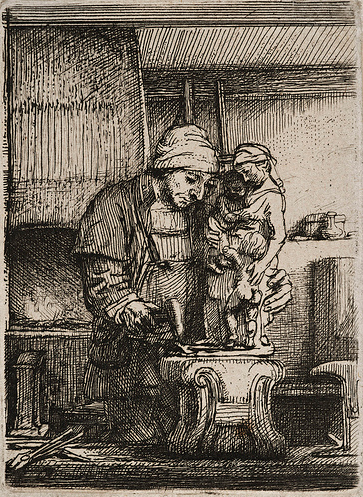Today’s post comes from Alec Aldrich, class of 2015 and Art Center volunteer.

The Goldsmith, 1655
Etching and drypoint on cream laid paper
Frances Lehman Loeb Art Center, Vassar College
Purchase, Friends of the Frances Lehman Loeb Art Center, 2012.8
Rembrandt van Rijn’s The Goldsmith (1655) was the smallest work in the Art Center’s
winter exhibition, Recent Acquisitions: Works on Paper, but it was well worth the
viewer’s attention. The intaglio print joins the ranks of numerous other intaglio prints
by the artist that are at the Art Center as a result of the Warburg family gift of Old
Master Prints in 1941, but these works are not often on view due to their light-sensitive
nature. Accordingly, an encounter with such a work is accompanied by the mystery of its
making. I hope to shed some light on this work in particular, but also the intaglio process
in general—a topic whose discussion often does not make it out of the Art Center’s print
room.
The Goldsmith measures a mere 3 ⅛ x 2 ¼ inches. The image’s namesake, the goldsmith,
can be found in the center of the image, hunching over his work. He wraps his arm
around his current project—a statuette of a modest woman and two children—while he
hammers out the base of his creation. Behind him to the left is a furnace for manipulating
the material of his trade.
Though it has the look of a drawing, Rembrandt rendered the image using two intaglio
printmaking methods, etching and drypoint. Both operations are typically performed on a
copper plate. The latter method requires the use of a pointed stylus with which the artist
laboriously scrapes directly on the plate. This rough process creates burr, the displaced
copper around the trough of the incised line, and causes the sketchy effect apparent in
the printed image. Etching, however, requires a few more steps. First, an acid-resistant
ground is applied to the copper plate. Then, the artist judiciously draws a stylus through
the ground, effectively rendering the image he or she desires, and then submerses this
elaborated side of the plate in an acid bath. The acid bites the plate where the ground
was removed with the stylus, creating the troughs in the plate. This effect can likewise
be manipulated to create strong or soft lines, creating an effect like a drawing in ink or
pencil. This combination trick—utilizing both etching and drypoint—characterizes many
of Rembrandt’s graphic works. It creates a very lively image since the lines appear to
vibrate with energy.
The Goldsmith, however, looms larger than its diminutive size not just because of
Rembrandt’s effective technical accomplishment, but also because of the meaning
suggested by the subject matter. The way the goldsmith embraces his work recalls the
action of a doting father and husband—his work is very much a labor of love. This
print, then, could be aligned with Rembrandt’s own personal sense of his art practice.
Accordingly, the sketchy quality of the image—like a preparatory drawing—reflects
the incomplete stage of the goldsmith’s statuette. Rembrandt shares with the viewer the
attentive, obsessive, enamored experience of an artist engrossed in his craft.




